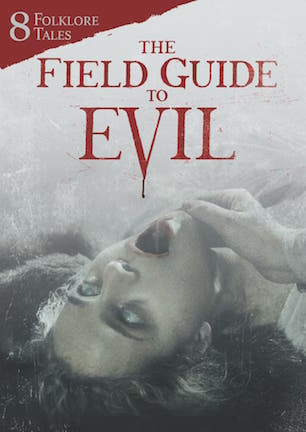Studio: Legion M
Director: Ashim Ahluwalia, Can Evrenol, Veronika Franz, Severin Fiala, Katrin Gebbe, Calvin Lee Reeder, Agnieszka Smoczynska, Peter Strickland, Yannis Veslemes
Writer: Robert Bolesto, Elif Domanic, Silvia Wolkan
Producer: Ant Timpson, Tim League
Stars: Various
Review Score:
Summary:
Eight horror stories from around the world explore frightening international folktales.
Review:
Regardless of whether or not the eight segments in “The Field Guide to Evil” click with you, and they certainly won’t with everyone, the motivation behind the movie’s making involves a fascinating filmmaking concept. Produced as a spiritual successor to the “ABCs of Death” anthologies, “The Field Guide to Evil” taps nine directors generally known for avant-garde indie fare to create short films based on fear-filled slices of folklore specific to their home countries.
What’s additionally intriguing is that these are lesser-known legends that many people, including residents of those regions, are unlikely to be familiar with. Romanian bloodsuckers, Japanese ghosts, and Scandinavian sasquatches sit this one out as we’re instead treated to unlikely tales involving an Austrian ‘Trud,’ a German ‘drude,’ and a childbirth djinn from Turkey.
If you have any familiarity with this filmmaking collective’s catalogue, which includes “Baskin” (review score), “Berberian Sound Studio” (review score), “Goodnight Mommy” (review here), and “The Lure” (review here) to name a few, then you have a starting reference point for the type of style in store. This eclectic, eccentric assembly of international creators regularly crafts content better suited for an arthouse than a grindhouse. This in turn means an audience has to be steeled for outside the box approaches, as “Field Guide” drapes itself in allegorical dreamscapes as opposed to easily digestible fright film fare.
“The Sinful Woman of Hollfall” as well as “The Kindler and the Virgin,” respectively the first and third segments, exemplify the anthology’s overall aesthetic. Both are beautifully shot pieces, a consistent trait throughout the octet’s entirety, almost scarily skilled at time travel transportation to countries and centuries seldom depicted in cinema. At a minimum, “The Field Guide to Evil” provides a terrific tour of times and places few other films visit.
Both are also burdened by their own ambiguity. “Field Guide” features a number of ‘Choose Your Own Conclusion’ narratives, with some thematic meanings more frustratingly opaque than others. As visually engrossing as it is, “The Kindler and the Virgin” in particular runs off the rails in expressing its intent. It’s one thing to ask a viewer to divine an isolated element in a film. It’s another when every inch of material remains open to interpretation.
Can Evrenol takes a straighter stab at the jugular with his shocker “Haunted by Al Karisi.” It’s a weird choice for following “The Sinful Woman of Hollfall” however, as their distinct lack of dialogue, prominent use of goats, and important incorporation of nightmares make them echo each other despite differences in their stories.
“Beware the Melonheads,” one of only two segments in English should subtitles be a factor for you, incorporates the same weirdo sensibilities that American director Calvin Reeder put on the table in “The Rambler” (review here). “Melonheads” is by far the campiest short in the movie, apparently intentionally, although its askew silliness combined with a contemporary setting makes it the black sheep of the bunch. Awful acting reddens an already sore thumb, yet its mid-movie placement offers an ideal opportunity for a bathroom break.
“Whatever Happened to Panagas the Pagan?” finds a more appealing way to be fun without sacrificing atmospheric eeriness. Taking place in 1984 Greece, the film feels dated even further back. An appropriately odd goblin supplies smirks while a macabre mauling of said creature supplies occult overtones. “Panagas” has another odd ending, but the crazily crooked path taken there makes the journey worthwhile.
Ashim Ahluwalia’s black and white “The Palace of Horrors” adds a little lick of Lovecraft. Set in 1913 India, the Ringling Brothers’ procurer of sideshow oddities takes a trip to a mad king’s palace to peek at an entity man was not meant to see. As with “Panagas,” the final reveal underwhelms in execution, yet the bizarre buildup couldn’t be more effectively unsettling.
Out of Germany, “A Nocturnal Breath” plays a lot like “The Sinful Woman of Hollfall” in terms of tone as well as fiction. At this point in the anthology, “The Field Guide to Evil” really feels the drag of its two-hour runtime. That dreamy quality alluded to earlier takes a bigger and bigger toll since, even with monsters and murders, the movie plays a patience game with slow to burn smolder.
Luckily, “Field Guide” saves perhaps the best, or at least the most purely enjoyable, segment for last. “Cobblers’ Lot” uncannily captures an authentic fractured fable feel with its silent film frame. Telling a fairy tale of two shoemaker brothers vying for the love of a princess, Peter Strickland’s Hungarian-set short ends the movie on a note light in spry spirit, but also dark in its deliciously demented moral.
As expected when dealing with an anthology from a diverse slate of men and women working separately, blood doesn’t flow at the same rate or intensity, resulting in an inconsistent experience that isn’t universally pleasing to all palates. While some of these experiments go up in a puff of smoke, all of them fire on smart efforts whose cinematic sincerity shines through independent of each piece’s success or failure. “The Field Guide to Evil” may not have long legs, but a terrific unifying hook is enough to earn appreciation as a memorable endeavor.
Review Score: 60






“Keeper” is more of a movie meant to highlight Tatiana Maslany’s talent anyway, and that is where the film sees its greatest success.